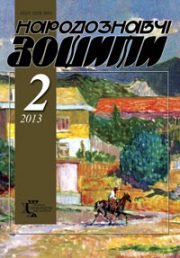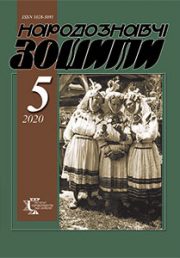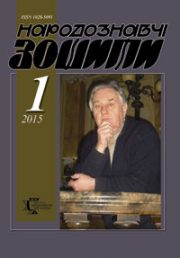The Ethnology Notebooks. 2023. № 3 (171), 567—585
UDK 930.2:738.011.26(477.51-2)”19/20″
DOI https://doi.org/10.15407/nz2023.03.567
POTTERY OF THE MIDDLE OF THE 20th AND EARLY 21th CENTURIES: LOCAL SPECIFICITY
BORENKO Nadiya
- ORCID ID: https://orcid.org/0009-0001-6961-2131
- Senior researcher of the scientific and collection department
- of the Museum of Folk Architecture and Life in Lviv
- Klymentii Sheptytskyi Museum of Folk Architecture and Life in Lviv;
- Researcher at the Department of Scientific and Archival Collections
- MAFKKUP SSCPCHMD
- 1, Chernecha Hora St., 79014, Lviv, Ukraine,
- Contacts: e-mail: borenjko@ukr.net; nadiyaborenko@gmail.com
Abstract. The article deals with the features of pottery of the North Chernihiv area at the end of XIX to modernity. The borders of researched territory within the area of the Middle Podesennya region have been defined. The processes of product formation, their firing, decor, assortment, names and artistic qualities are covered. The state of pottery is briefly analyzed. The article contains the analysis of the pottery craft of the Oleshnya village in the Ripkynskyi area, where lives and works national Ukrainian master Ivan Bibik; as well as pottery craft of the townSemenyvka, where dynasty potter Oleksiy Sakovskiy making pottery foodware with traditional technology. The paper includs folklore material about supernatural skills of potter-wizard.
The use of pottery in traditional life, as well as the assignment of ritual and symbolic signs to certain types of dishes, is considered. The example of the «full-empty» opposition emphasizes the relic remnants of the patriarchal system in the system of two-food diet of Ukrainians of Chernihiv Polissya.
The purpose of the article is to characterize the past and present state of the pottery industries in the historical and geographical region of Middle Podesenia in a historical and comparative aspect, an analysis of the ethnographic features of production, formative and artistic features of specific and typological groups of dishes.
The subject of the study is production technology, local features of formation, assortment and artistic qualities of products, rules and customs of pottery and the buying and selling process, the former and current state of the industry, the functional purpose of pottery in traditional household and ceremonial culture, and folklore materials about the potter’s abilities.
The territorial limits of the study are the historical and geographical regions of the Middle Podesenia.
The chronological boundaries of the study are the second half of the 19th century and the beginning of the 21st century.
The source base of the research is the materials collected by the author in 2017. and 2019 as part of complex historical and ethnographic expeditions of the State Center for the Protection of Cultural Heritage from Man-made Disasters in the Middle Podesnya.
A brief analysis of the state of pottery in the village of Oleshnya of the Ripky district, where the folk craftsman of Ukraine Ivan Bibyk continues to work, and in the district town of Semenivka, where the dynastic potter Oleksiy Sakovsky makes household pottery using traditional technology. Added folklore material about the extraordinary abilities of the potter-wizard.
The research methodology is based on historical review, systematization and generalization, theoretical analysis and observations of the author.
Keywords: potter, pottery craft, pottery school, clay, baking, furnace, products, sell.
Received 24.04.2023
REFERENCES
- Mohylchenko, M. (1899). Pottery in Oleshniа village, Chernihiv region. Materialy do ukrainsko-ruskoi etnolohii (Vol. 1, pp. 53—65) [in Ukrainian].
- Spaska, Yevheniia. (1929). Hlechyk z khrestykom. Materialy do etnolohii i antropolohii (Vol. XXI—XXII, part 1, pp. 38—43) [in Ukrainian].
- Fryde, Mariia. (1926). Honcharstvo na yuhe Chernyhovshchyny. Materyalу po еtnohrafіі (Vol. 3, issue 1, pp. 45—58) [in Russian].
- Lashchuk, Yu. (1971). Ukrainian folk ceramics of the 19th and 20th centuries. Avtoreferat dyss. na soisk. uch. stepeny doktora iskusstvovedeniya [in Russian].
- Mateiko, K. (1959). Folk ceramics of the western regions of the Ukrainian SSR. Kyiv: Naukova dumka [in Ukrainian].
- Poshyvailo, Oles. (1993). Ethnography of Ukrainian pottery. Left-bank Ukraine. Kyiv: Molod [in Ukrainian].
- Poshyvailo, Ihor. (2000). Phenomenology of pottery. Semiotic and ethnological aspects. Opishne: Ukrainske Narodoznavstvo [in Ukrainian].
- Miroshnychenko, Olena. (2005). The current state of pottery in the village of Oleshnia, Ripky district, Chernihiv region. Ukrainskyi keramolohichnyi zhurnal, 1—4, 177—178 [in Ukrainian].
- Ovcharenko, L. (2004). Zemstvo pottery training workshop in the village of Oleshnya, Chernihiv province (1895—1898). Ukrainskyi keramolohichnyi zhurnal, 2—3, 105—118 [in Ukrainian].
- Kolupaieva, Ahniia. (2006). Ukrainian tiles of the 14th and early 20th centuries. Lviv [in Ukrainian].
- Shmahalo, Rostyslav. (2004). Pottery and entrepreneurship: a look through the centuries (based on the experience of the pottery training workshop in the village of Oleshni, Chernihiv region). Narodoznavchi zoshyty, 1—2, 110—115 [in Ukrainian].
- Shtankina, Iryna. (2004). The «flowerpot» motif in the decor of Chernihiv tiles of the 17th and early 20th centuries. Narodoznavchi zoshyty, 1—2, 98—109 [in Ukrainian].
- Serzhant, Liudmyla. (2008). The Origins of the Symbolism of the Form and Ornamentation of Chernihiv Region Ceramics. Ukrainske mystetstvoznavstvo, 8, 157—165 [in Ukrainian].
- Motyl, Romana. (2011). Ukrainian smoked ceramics of the 19th and early 21st centuries. Typology. Artistic features. Lviv: The Ethnology Institute NAS of Ukraine. [in Ukrainian].
- Kutsenko, Tetiana. (1995). From the history of pottery in Oleshnya. Siverianskyi litopys, 2, 38—43 [in Ukrainian].
- Berezhniak, Valentyna. From the vocabulary of Eastern Polissya potters. Polissya: language, culture, history. Materials of the international conference (Pp. 127—133) Kyiv[in Ukrainian].
- Shcherban, Olena. (2014). Hogweed — for borscht, kashnik — for porridge. Dim i Simia, 4, 37—38 [in Ukrainian].
- Shcherban, O. (2007). About cooking borscht and porridge in a clay pot. Mynule i suchasne Volyni i Polissia: rode nash krasnyi. Materialy Tretoi Volynskoi oblasnoi naukovo-etnohrafichnoi konferentsii (Pp. 139—141). Lutsk [in Ukrainian].
- Rusov, Mykhailo. (1905). Pottery in the village of Oposhnia, Poltava region. Materialy do ukrainsko-ruskoi etnolohii, 4, 41—59 [in Ukrainian].
- Metka, L. (2011). Pottery of Sloboda Ukraine in the second half of the 19th and first half of the 20th century. Poltava [in Ukrainian].
- Borenko, Nadiia. (2019). Pottery Crafts of the Northern Chernihiv Region in the Late Nineteenth and Early Twenty-First Centuries: A Comparative Aspect. An open-air museum in the socio-cultural space. Materialy mizhnarodnoi naukovoi konferentsii, prysviachenoi 50-richchiu zasnuvannia Natsionalnoho muzeiu narodnoi arkhitektury ta pobutu Ukrainy (Pp. 38—48). Kyiv [in Ukrainian].
- Podesinnia. Retrieved from: https://uk.wikipedia.org>wiki> Podesinnia (Last accessed: 19.11.2021).
- Mostiaiev, Oleksandr. (2012). Historical fate of regions as a criterion of political and ethnographic zoning of Ukraine. 7th International Congress of Ukrainian Studies. Ethnology (Pp. 135—149). Kyiv [in Ukrainian].
- Balushok, Vasyl. (2012). Ethnic Differences between Ukrainians and Belarusians in Medieval and Early Modern Times. 7th International Congress of Ukrainian Studies (Pp. 17—29). Kyiv [in Ukrainian].
- Horlenko, Volodymyr. (1999). Ethnographic groups. Ukrainians. Historical and ethnographic monograph, 1, 140—142 [in Ukrainian].
- Borenko, N.V. Author’s collections of field audio recordings. MAFKKUP SSCPCHMD. Fond analohovykh dokumentiv. AK-[Semenivka-(UII-UIII)-2019-Borenko-10]. Recording from N. Kholodilo, 1952, v. Arkhypivka Novhorod-Siverskiy region Chernihivskа obl. The 3d of August 2019 [in Ukrainian].
- Borenko, N.V. Author’s collections of field audio recordings. MAFKKUP SSCPCHMD. Collection of analog documents. AK-[Semenivka-(UII-UIII)-2019-Borenko-14]. Recording from N. Nashyvan, 1949, v. Pushkari Novhorod-Siverskyi region Chernihivska obl. The 7 th of August 2019 [in Ukrainian].
- Bibik Ivan Ivanovych. Retrieved from: https://chor.gov.ua>Nashadiyalnist>Anonsy (Last accessed: 19.11.2021) [in Ukrainian].
- People: Life’s vicissitudes of the oldest potter. Retrieved from: https://cheline.com.ua>people>zhittyevi_peripetiyi (Last accessed: 19.11.2021) [in Ukrainian].
- Borenko, N.V. Author’s collections of field audio recordings. MAFKKUP SSCPCHMD. Collection of analog documents. AK-[Ripky-(UII-UIII)-2017-Borenko-6]. Recording from I. Bibik, 1925, v. Oleshnia Ripkynskyi region Chernihivska obl. The 1st of August 2017 [in Ukrainian].
- Vovk, Fedir. (2015). Ethnographic features of the Ukrainian people. Studies in Ukrainian ethnography and anthropology. Kharkiv: Vydavnytstvo O. Harkushi [in Ukrainian].
- Borenko, N.V. Author’s collections of field audio recordings. MAFKKUP SSCPCHMD. Collection of analog documents. AK-[Ripky-(UII-UIII)-2017-Borenko-1]. Recording from H. Vorobei, 1937, v. Lovyn Ripkynskyi region Chernihivska obl. 1 august 2017 [in Ukrainian].
- Borenko, N.V. Author’s collections of field audio recordings. MAFKKUP SSCPCHMD. Collection of analog documents. AK-[Ripky-(UII-UIII)-2017-Borenko-1]. Recording from A. Botiaia, 1944. V. Hrabiv Ripkynskyi region Chernihivska obl. The 27th of July 2017 [in Ukrainian].
- Borenko, N.V. Author’s collections of field audio recordings. MAFKKUP SSCPCHMD. Collection of analog documents. AK-[Semenivka-(UII-UIII)-2019-Borenko-8]. Recording from O. Sakovskoho, 1983, v. Semenivka Chernihivska obl. The 1st of August 2019 [in Ukrainian].
- Borenko, N.V. Author’s collections of field audio recordings. MAFKKUP SSCPCHMD. Collection of analog documents. AK-[Ripky-(UII-UIII)-2017-Borenko-1]. Recording from Shmarovoz O.D., 1969 r. n. v s. Hrabiv Ripkynskyi region Chernihivska obl. The 27 of July 2017 [in Ukrainian].
- Borenko, N.V. Author’s collections of field audio recordings. MAFKKUP SSCPCHMD. Collection of analog documents. AK-[Semenivka-(UII-UIII)-2019-Borenko-5]. Recording from A. Bokach, 1938, v. Orlykivka region Chernihivska obl. The 29 of July 2019 [in Ukrainian].
- Borenko, N.V. Author’s collections of field audio recordings. MAFKKUP SSCPCHMD. Collection of analog documents. AK-[Semenivka-(UII-UIII)-2019-Borenko-2]. Recording from L. Hrybuli, 1941, v. Tymonovychi region Chernihivska obl. The 26 of July 2019 [in Ukrainian].
- Borenko, N.V. Author’s collections of field audio recordings. MAFKKUP SSCPCHMD. Collection of analog documents. AK-[Semenivka-(UII-UIII)-2019-Borenko-13]. Recording from V. Zazai, 1974, v. Kudlaivka region Chernihivska obl. The 6 of August 2019 [in Ukrainian].
- Borenko, N.V. Author’s collections of field audio recordings. MAFKKUP SSCPCHMD. Collection of analog documents. AK-[Semenivka-(UII-UIII)-2019-Borenko-6]. Recording from N. Revun, 1950, v. Radomka Novhorod-Siverskyi region Chernihivskoi obl. The of 30 July 2019 [in Ukrainian].
- Borenko, N.V. Author’s collections of field audio recordings. MAFKKUP SSCPCHMD. Collection of analog documents. AK-[Semenivka-(UII-UIII)-2019-Borenko-15]. Recording from N. Kovryzhko, 1958, v. Pecheniuhy Novhorod-Siverskyi region Chernihivska obl. The 8 of August 2019 [in Ukrainian].
- Borenko, N.V. Author’s collections of field audio recordings. MAFKKUP SSCPCHMD. Collection of analog documents. AK-[Semenivka-(UII-UIII)-2019-Borenko-12]. Recording from Revenok H.M., 1945, v. Prokopivka Novhorod-Siverskyi region Chernihivska obl. The 5 of August 2019 [in Ukrainian].
- Borenko, N.V. Author’s collections of field audio recordings. MAFKKUP SSCPCHMD. Collection of analog documents. AK-[Semenivka-(UII-UIII)-2019-Borenko-7]. Recording by Nadiya Borenko from L. Korobko, 1957, v. Pohoriltsi Novhorod-Siverskohyi region Chernihivska obl. The 31 of July 2019 [in Ukrainian].






